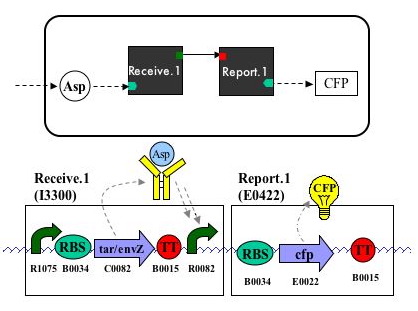IAP 2004:Aspartate Receiver
From 2006.igem.org
Aspartate Receiver
Devices
The Tar-EnvZ attractant receiver device converts chemical binding of aspartate to production of transcription factors. The fusion protein Tar- EnvZ (C0082) combines the extracellular and transmembrane domains of Tar with the intracellular domain of EnvZ. Tar is the bacterial chemotaxis receptor for aspartate. EnvZ is an osmosensor kinase, which, through phosphorylation of OmpR, regulates transcription of porin genes.
A constitutive promoter (R1075) drives constant production of the Tar-EnvZ fusion. Once aspartate binds to Tar, EnvZ will phosphorylate OmpR, which will then bind to an OmpR promoter (R0082/R0083/R0084). The OmpR promoter sends TIPS out to the switch input device, turning the switch ON if aspartate has been bound.
Three variations of the attractant receiver device exist: I3300, I3301, and I3302. These variations are due to three different versions of the OmpR promoter. I3300 uses the R0082 promoter, taken from the upstream region of ompC, a porin gene. I3301 uses the R0083 promoter, a truncated version of the upstream region of ompC. I3302 uses the R0084 promoter, taken from the upstream region of ompF, a different porin gene. OmpR has been shown to bind to all three of these upstream regions. The efficacies of the different promoters in terms of our particular system must be experimentally determined.
Tar-EnvZ CDS (C0082) Tar-EnvZ consists of 484 amino acid residues. The NH-2 terminal has 255 residues derived from Tar, and the COOH terminal has 229 residues derived from EnvZ. The two genes are fused at their unique NdeI (CATATG) restriction sites, as described in Utsumi R., et al (1989).
A silent point mutation was made at base 423 (A -> C) to eliminate an XbaI restriction enzyme site. The mutation was designed to match codons with similar frequencies of usage in E. coli.
